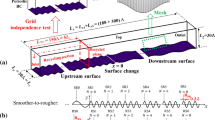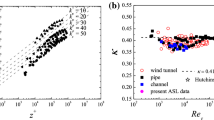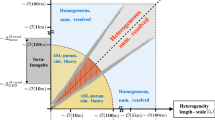Abstract
Contrary to Monin–Obukhov similarity theory, near-surface atmospheric turbulence depends not only on local motions but also on larger-scale motions associated with the full atmospheric boundary layer (ABL), where they themselves evolve in character with thermal stratification. After reviewing our current knowledge of ABL motions, we present wavelet velocity and air temperature spectra for both eddy-surface-layer (ESL) flows above rough surfaces and roughness-sublayer (RSL) flows above vegetation canopies, both flows characterizing turbulence over two scales of land roughness. Spectra are extended to the production scale to identify the influence of ABL-scale motions following the thermal stratification. Contrary to turbulence in the ESL, RSL turbulence appears weakly enhanced by ABL-scale motions in near-neutral regimes. With increasing influence of buoyancy, ABL-scale motions play a larger role in ESL and RSL flows, dominating the locally produced turbulence in free convection, while acting to decouple local from the large-scale motions in the stable regime. The behaviour of ESL and RSL spectra with stability variations support the view of, (1) canopy-scale eddies dominating the canopy turbulence over the larger ABL-scale motions in windy conditions, (2) ABL-scale motions known as very-large-scale motions (VLSMs) influencing the ESL horizontal velocity turbulence in windy conditions, and (3) the progressive transitioning of ABL-scale motions from VLSMs to thermals with instability in ESL flows. The direct contribution of ABL-scale motions to near-surface momentum and heat turbulent fluxes appears small. Finally, near-surface velocity spectra are well-approximated as a linear superposition of individual spectra associated to the main eddies populating the flow.










Similar content being viewed by others
References
Adrian RJ (2007) Hairpin vortex organization in wall turbulence. Phys Fluids 19(041):301. https://doi.org/10.1063/1.2717527
Angevine WM, Edwards JM, Lothon M, LeMone MA, Osborne SR (2020) Transition periods in the diurnally-varying atmospheric boundary layer over land. Boundary-Layer Meteorol 177:205–223. https://doi.org/10.1007/s10546-020-00515-y
Antonia RA, Raupach MR (1993) Spectral scaling in a high Reynolds number laboratory boundary layer. Boundary-Layer Meteorol 65:289–306. https://doi.org/10.1007/bf00705531
Atkinson BW, Zhang JW (1996) Mesoscale shallow convection in the atmosphere. Rev Geophys 34(4):403–431. https://doi.org/10.1029/96rg02623
Baars WJ, Talluru KM, Hutchins N, Marusic I (2015) Wavelet analysis of wall turbulence to study large-scale modulation of small scales. Exp Fluids 56(10):188. https://doi.org/10.1007/s00348-015-2058-8
Bailey BN, Stoll R (2016) The creation and evolution of coherent structures in plant canopy flows and their role in turbulent transport. J Fluid Mech 789:425–460. https://doi.org/10.1017/jfm.2015.749
Banerjee T, Katul GG, Salesky ST (2015) Revisiting the formulations for the longitudinal velocity variance in the unstable atmospheric surface layer. Q J R Meteorol Soc 141(690, A):1699–1711. https://doi.org/10.1002/qj.2472
Bradshaw P (1967) ‘Inactive’ motion and pressure fluctuations in turbulent boundary layers. J Fluid Mech 30(2):241–258. https://doi.org/10.1017/s0022112067001417
Bradshaw P (1978) Comments on “horizontal velocity spectra in an unstable surface layer”. J Atmos Sci 35:1768–1769. https://doi.org/10.1175/1520-0469(1978)035<1768:covsia>2.0.co;2
Brasseur JG, Wei C (1994) Interscale dynamics and local isotropy in high Reynolds number turbulence within triadic interactions. Phys Fluid 6(2):842–870. https://doi.org/10.1063/1.868322
Calaf M, Hultmark M, Oldroyd HJ, Simeonov V, Parlange MB (2013) Coherent structures and the \(k^{-1}\) spectral behaviour. Phys Fluid. https://doi.org/10.1063/1.4834436
Chamecki M, Dias NL, Salesky ST, Pan Y (2017) Scaling laws for the longitudinal structure function in the atmospheric surface layer. J Atmos Sci 74(4):1127–1147. https://doi.org/10.1175/jas-d-16-0228.1
Cheynet E, Jakobsen JB, Reuder J (2018) Velocity spectra and coherence estimates in the marine atmospheric boundary layer. Boundary-Layer Meteorol 169:429–460. https://doi.org/10.1007/s10546-018-0382-2
Darbieu C, Lohou F, Lothon M, de Arellano JVG, Couvreux F, Durand P, Pino D, Patton EG, Nilsson E, Blay-Carreras E, Gioli B (2015) Turbulence vertical structure of the boundary layer during the afternoon transition. Atmos Chem Phys 15(17):10,071-10,086. https://doi.org/10.5194/acp-15-10071-2015
Deardorff JW (1972) Numerical investigation of neutral and unstable planetary boundary layer. J Atmos Sci 29:91–115. https://doi.org/10.1175/1520-0469(1972)029<0091:nionau>2.0.co;2
Denmead OT, Bradley EF (1987) On scalar transport in plant canopies. Irrig Sci 8:131–149. https://doi.org/10.1007/bf00259477
Domingues MO, Mendes O Jr, da Costa AM (2005) On wavelet techniques in atmospheric sciences. Adv Space Res 35:831–842. https://doi.org/10.1016/j.asr.2005.02.097
Drobinski P, Carlotti P, Newsom RK, Banta RM, Foster RC, Redelsperger JL (2004) The structure of the near-neutral atmospheric surface layer. J Atmos Sci 61:699–714. https://doi.org/10.1175/1520-0469(2004)061<0699:tsotna>2.0.co;2
Dupont S (2020) Scaling of dust flux with friction velocity: time resolution effects. J Geophys Res Atmos. https://doi.org/10.1029/2019jd031192
Dupont S, Patton EG (2012a) Influence of stability and seasonal canopy changes on micrometeorology within and above an orchard canopy: the chats experiment. Agric For Meteorol 157:11–29. https://doi.org/10.1016/j.agrformet.2012.01.011
Dupont S, Patton EG (2012b) Momentum and scalar transport within a vegetation canopy following atmospheric stability and seasonal canopy changes: the CHATS experiment. Atmos Chem Phys 12:5913–5935. https://doi.org/10.5194/acp-12-5913-2012
Dupont S, Rajot JL, Labiadh M, Bergametti G, Alfaro S, Bouet C, Fernandes R, Khalfallah B, Lamaud E, Marticorena B, Bonnefond JM, Chevaillier S, Garrigou D, Henry-des-Tureaux T, Sekrafi S, Zapf P (2018) Aerodynamic parameters over an eroding bare surface: reconciliation of the Law-of-the-wall and Eddy-Covariance determinations. J Geophys Res 123:4490–4508. https://doi.org/10.1029/2017jd027984
Dupont S, Rajot JL, Labiadh M, Bergametti G, Lamaud E, Irvine M, Alfaro S, Bouet C, Fernandes R, Khalfallah B, Marticorena B, Bonnefond JM, Chevaillier S, Garrigou D, Henry-des-Tureaux T, Sekrafi S, Zapf P (2019) Dissimilarity between dust, heat, and momentum turbulent transports during aeolian soil erosion. J Geophys Res. https://doi.org/10.1029/2018jd029048
Dupont S, Argoul F, Gerasimova-Chechkina E, Irvine MR, Arneodo A (2020) Experimental evidence of a phase transition in the multifractal spectra of turbulent temperature fluctuations at a forest canopy top. J Fluid Mech 896:A15. https://doi.org/10.1017/jfm.2020.348
Fesquet C, Dupont S, Drobinski P, Dubos T, Barthlott C (2009) Impact of terrain heterogeneity on coherent structure properties: numerical approach. Boundary-Layer Meteorol 133:71–92. https://doi.org/10.1007/s10546-009-9412-4
Finnigan JJ, Shaw RH, Patton EG (2009) Turbulence structure above a vegetation canopy. J Fluid Mech 637:387–424. https://doi.org/10.1017/s0022112009990589
Ganapathisubramani B, Longmire E, Marusic I (2003) Characteristics of vortex packets in turbulent boundary layers. J Fluid Mech 478:35–46. https://doi.org/10.1017/s0022112002003270
Gao Z, Liu H, Russell ES, Huang J, Foken T, Oncley SP (2016) Large eddies modulating flux convergence and divergence in a disturbed unstable atmospheric surface layer. J Geophys Atmos 121(4):1475–1492. https://doi.org/10.1002/2015jd024529
Gerz T, Howell J, Mahrt L (1994) Vortex structures and microfronts. Phys Fluids 6(3):1242–1251. https://doi.org/10.1063/1.868293
Ghannam K, Katul GG, Bou-Zeid E, Gerken T, Chamecki M (2018) Scaling and similarity of the anisotropic coherent eddies in near-surface atmospheric turbulence. J Atmos Sci 75:943–964. https://doi.org/10.1175/jas-d-17-0246.1
Guala M, Hommema S, Adrian R (2006) Large-scale and very-large-scale motions in turbulent pipe flow. J Fluid Mech 554:521–542. https://doi.org/10.1017/s0022112006008871
Harman IN, Finnigan JJ (2007) A simple unified theory for flow in the canopy and roughness sublayer. Boundary-Layer Meteorol 123:339–363. https://doi.org/10.1007/s10546-006-9145-6
Harman IN, Finnigan JJ (2008) Scalar concentration profiles in the canopy and roughness sublayer. Boundary-Layer Meteorol 129:323–351. https://doi.org/10.1007/s10546-008-9328-4
Heisenberg W (1948) On the theory of statistical and isotropic turbulence. Proc R Soc Lond 195:402–406. https://doi.org/10.1007/978-3-642-61659-4_8
Högström U, Hunt J, Smedman A (2002) Theory and measurements for turbulence spectra and variances in the atmospheric neutral surface layer. Boundary-Layer Meteorol 103(1):101–124. https://doi.org/10.1023/a:1014579828712
Højstrup J (1982) Velocity spectra in the unstable planetary boundary-layer. J Atmos Sci 39(10):2239–2248. https://doi.org/10.1175/1520-0469(1982)039<2239:vsitup>2.0.co;2
Horst T (2019) NCAR/EOL ISFS CHATS high rate tower and array data. Version 2. https://doi.org/10.26023/P4JW-9T0T-QG0S
Horst TW, Oncley SP (2006) Corrections to inertial-range power spectra measured by CSAT3 and solent sonic anemometers, 1. Path-averaging erros. Boundary-Layer Meteorol 119:375–395. https://doi.org/10.1007/s10546-005-9015-7
Hunt JCR, Graham JMR (1978) Free-stream turbulence near plane boundaries. J Fluid Mech 84:209–235. https://doi.org/10.1017/s0022112078000130
Hunt J, Morrison JF (2000) Eddy structure in turbulent boundary layers. Euro J Mech B Fluids 19:673–694. https://doi.org/10.1016/s0997-7546(00)00129-1
Hunt J, Carlotti P (2001) Statistical structure at the wall of the high Reynolds number turbulent boundary layer. Flow Turb Comb 66(4):453–475. https://doi.org/10.1023/A:1013519021030
Hutchins N, Marusic I (2007) Evidence of very long meandering features in the logarithmic region of turbulent boundary layers. J Fluid Mech 579:1–28. https://doi.org/10.1017/s0022112006003946
Jayaraman B, Brasseur JG (2021) Transition in atmospheric boundary layer turbulence structure from neutral to convective, and large-scale rolls. J Fluid Mech 913:A42. https://doi.org/10.1017/jfm.2021.3
Kader BA, Yaglom AM (1991) Spectra and correlation functions of surface layer turbulence in unstable thermal stratification. In: Turbulence and coherent structures. Kluwer Academic Press, New York, pp 388–412. https://doi.org/10.1007/978-94-015-7904-9_24
Kaimal JC (1978) Horizontal velocity spectra in an unstable surface layer. J Atmos Sci 35:18–24. https://doi.org/10.1175/1520-0469(1978)035<0018:hvsiau>2.0.co;2
Kaimal JC, Finnigan JJ (1994) Atmospheric boundary layer flows. Their structure and measurements. Oxford University Press, New-York. https://doi.org/10.1093/oso/9780195062397.001.0001
Kaimal JC, Wyngaard JC, Izumi Y, Coté OR (1972) Spectral characteristics of surface-layer turbulence. Q J R Meteorol Soc 98:563–589. https://doi.org/10.1002/qj.49709841707
Kaimal JC, Wyngaard JC, Haugen DA, Coté OR, Izumi Y (1976) Turbulence structure in the convective boundary layer. J Atmos Sci 33:2152–2169. https://doi.org/10.1175/1520-0469(1976)033<2152:tsitcb>2.0.co;2
Katul GG (2019) The anatomy of large-scale motion in atmospheric boundary layers. J Fluid Mech 858:1–4. https://doi.org/10.1017/jfm.2018.731
Katul GG, Parlange MB (1994) On the active role of temperature in surface-layer turbulence. J Atmos Sci 51(15):2181–2195. https://doi.org/10.1175/1520-0469(1994)051<2181:otarot>2.0.co;2
Katul GG, Parlange MB (1995) The spatial structure of turbulence at production wavenumbers using orthonormal wavelets. Boundary-Layer Meteorol 75:81–108. https://doi.org/10.1007/bf00721045
Katul G, Chu C (1998) A theoretical and experimental investigation of energy-containing scales in the dynamic sublayer of boundary-layer flows. Boundary-Layer Meteorol 86(2):279–312. https://doi.org/10.1023/a:1000657014845
Katul G, Chang W (1999) Principal length scales in second-order closure models for canopy turbulence. J Appl Meteorol 38:1631–1643. https://doi.org/10.1175/1520-0450(1999)038<1631:plsiso>2.0.co;2
Katul GG, Albertson JD, Hsieh CI, Conklin PS, Sigmon JT, Knoerr Parlange KR M B (1996) The “inactive” eddy motion and the large-scale turbulent pressure fluctuations in the dynamic sublayer. J Atmos Sci 53:2512–2524. https://doi.org/10.1175/1520-0469(1996)053<2512:tematl>2.0.co;2
Katul GG, Porporato A, Nikora V (2012) Existence of \(k^{-1}\) power-law scaling in the equilibrium regions of wall-bounded turbulence explained by heisenberg’s eddy viscosity. Phys Rev E 86(066):311. https://doi.org/10.1103/PhysRevE.86.066311
Khanna S, Brasseur JG (1997) Analysis of Monin–Obukhov similarity from large-eddy simulation. J Fluid Mech 345:251–286. https://doi.org/10.1017/s0022112097006277
Khanna S, Brasseur JG (1998) Three-dimensional buoyancy- and shear-induced local structure of the atmospheric boundary layer. J Atmos Sci 55(5):710–743. https://doi.org/10.1175/1520-0469(1998)055<0710:tdbasi>2.0.co;2
Kim KC, Adrian RJ (1999) Very large-scale motion in the outer layer. Phys Fluids 11(2):417–422. https://doi.org/10.1063/1.869889
Larsen XG, Larsen SE, Petersen EL (2016) Full-scale spectrum of boundary-layer winds. Boundary-Layer Meteorol 159(2):349–371. https://doi.org/10.1007/s10546-016-0129-x
Lee JH, Sung HJ (2011) Very-large-scale motions in a turbulent boundary layer. J Fluid Mech 673:80–120. https://doi.org/10.1017/s002211201000621x
Lemone MA (1973) The structure and dynamics of horizontal roll vortices in the planetary boundary layer. J Atmos Sci 30:1077–1091. https://doi.org/10.1175/1520-0469(1973)030<1077:tsadoh>2.0.co;2
Li D, Katul GG, Gentine P (2016) The \(k^{-1}\) scaling of air temperature spectra in atmospheric surface layer flows. Q J R Meteorol Soc 142(694, A):496–505. https://doi.org/10.1002/qj.2668
Li Q, Gentine P, Mellado JP, McColl KA (2018) Implications of nonlocal transport and conditionally averaged statistics on Monin–Obukhov similarity theory and Townsend’s attached eddy hypothesis. J Atmos Sci 75(10):3403–3431. https://doi.org/10.1175/jas-d-17-0301.1
Mahrt L (2014) Stably stratified atmospheric boundary layers. Ann Rev Fluid Mech 46:23–45. https://doi.org/10.1146/annurev-fluid-010313-141354
Marusic I, Hutchins N (2008) Study of the log-layer structure in wall turbulence over a very large range of Reynolds number. Flow Turb Comb 81:115–130. https://doi.org/10.1007/s10494-007-9116-0
Marusic I, Monty JP (2019) Attached eddy model of wall turbulence. Annu Rev Fluid Mech 51:49–74. https://doi.org/10.1146/annurev-fluid-010518-040427
Mathis R, Hutchins N, Marusic I (2009) Large-scale amplitude modulation of the small scale structures in turbulent boundary layers. J Fluid Mech 628:311–337. https://doi.org/10.1017/s0022112009006946
McNaughton K (2004) Turbulence structure of the unstable atmospheric surface layer and transition to the outer layer. Boundary-Layer Meteorol 112(2):199–221. https://doi.org/10.1023/b:boun.0000027906.28627.49
McNaughton K, Laubach J (2000) Power spectra and cospectra for wind and scalars in a disturbed surface layer at the base of an advective inversion. Boundary-Layer Meteorol 96(1–2):143–185. https://doi.org/10.1023/a:1002477120507
McNaughton KG, Clement RJ, Moncrieff JB (2007) Scaling properties of velocity and temperature spectra above the surface friction layer in a convective atmospheric boundary layer. Nonlinear Process Geophys 14(3):257–271. https://doi.org/10.5194/npg-14-257-2007
Mikkelsen T, Larsen SE, Jorgensen HE, Astrup P, Larsen XG (2017) Scaling of turbulence spectra measured in strong shear flow near the Earth’s surface. Phys Scr. https://doi.org/10.1088/1402-4896/aa91b2
Moeng CH, Sullivan PP (1994) Comparison of shear- and buoyancy-driven planetary boundary layer flows. J Atmos Sci 51:999–1022. https://doi.org/10.1175/1520-0469(1994)051<0999:acosab>2.0.co;2
Monin AS, Obukhov AMF (1954) Basic laws of turbulent mixing in the surface layer of the atmosphere. Tr Akad Nauk SSSR Geophiz 24(151):163–187
Morrison JF, Jiang W, McKeon BJ, Smits AJ (2002) Reynolds number dependence of streamwise velocity spectra in turbulent pipe flow. Phys Rev Lett 88(21):214,501. https://doi.org/10.1103/physrevlett.88.214501
Nickels T, Marusic I, Hafez S, Chong M (2005) Evidence of the \(k^{-1}\) law in a high-Reynolds-number turbulent boundary layer. Phys Rev Lett. https://doi.org/10.1103/PhysRevLett.95.074501
Nikora V (1999) Origin of the “-1’’ spectral law in wall-bounded turbulence. Phys Rev Lett 83(4):734–736. https://doi.org/10.1103/PhysRevLett.83.734
Obukhov AM (1946) Turbulence in an atmosphere with a non-uniform temperature. Tr Inst Teor Geofiz Akad Nauk SSSR 1:95–115. https://doi.org/10.1007/bf00718085
Pan Y, Chamecki M (2016) A scaling law for the shear-production range of second-order structure functions. J Fluid Mech 801:459–474. https://doi.org/10.1017/jfm.2016.427
Patton EG, Horst TW, Sullivan PP, Lenschow DH, Oncley SP, Brown OJ, Burns SP, Guenther AB, Held A, Karl T, Mayor SD, Rizzo LV, Spuler SM, Sun J, Turnipseed A, Allwine EJ, Edburg SL, Avissar Lamb R B K, Calhoun RJ, Kleissl J, Massman WJ, Paw UKT, Weil JC (2011) The canopy horizontal array turbulence study. Bull Am Meteorol Soc 92:593–611. https://doi.org/10.1175/2010bams2614.1
Patton EG, Sullivan PP, Shaw RH, Finnigan JJ, Weil JC (2016) Atmospheric stability influences on coupled boundary layer and canopy turbulence. J Atmos Sci 73(4):1621–1647. https://doi.org/10.1175/jas-d-15-0068.1
Perret L, Patton EG (2021) Stability influences on interscale transport of turbulent kinetic energy and Reynolds shear stress in atmospheric boundary layers interacting with a tall vegetation canopy. J Fluid Mech 921:A14. https://doi.org/10.1017/jfm.2021.453
Perry AE, Henbest S, Chong MS (1986) A theoretical and experimental study of wall turbulence. J Fluid Mech 165:163–199. https://doi.org/10.1017/s002211208600304x
Raupach MR, Antonia RA, Rajagopalan S (1991) Rough wall turbulent boundary layers. Appl Mech Rev 44:1–25. https://doi.org/10.1115/1.3119492
Raupach MR, Finnigan JJ, Brunet Y (1996) Coherent eddies and turbulence in vegetation canopies: The mixing-layer analogy. Boundary-Layer Meteorol 78(3–4):351–382. https://doi.org/10.1007/978-94-017-0944-6_15
Reynolds RT, Hayden P, Castro IP, Robins AG (2007) Spanwise variations in nominally two-dimensional rough-wall boundary layers. Exp Fluids 42(2):311–320. https://doi.org/10.1007/s00348-006-0243-5
Salesky ST, Chamecki M (2012) Random errors in turbulence measurements in the atmospheric surface layer: Implications for Monin-Obukhov similarity theory. J Atmos Sci 69:3700–3714. https://doi.org/10.1175/jas-d-12-096.1
Salesky ST, Anderson W (2018) Buoyancy effects on large-scale motions in convective atmospheric boundary layers: implications for modulation of near-wall processes. J Fluid Mech 856:135–168. https://doi.org/10.1017/jfm.2018.711
Salesky ST, Chamecki M, Bou-Zeid E (2017) On the nature of the transition between roll and cellular organization in the convective boundary layer. Boundary-Layer Meteorol 163(1):41–68. https://doi.org/10.1007/s10546-016-0220-3
Schaller C, Göckede M, Foken T (2017) Flux calculation of short turbulent events—comparison of three methods. Atmos Meas Tech 10:869–880. https://doi.org/10.5194/amt-10-869-2017
Shapkalijevski M, Moene AF, Ouwersloot HG, Patton EG, Vila-Guerau de Arellano J (2016) Influence of canopy seasonal changes on turbulence parameterization within the roughness sublayer over an orchard canopy. J Appl Meteorol Clim 55:1391–1407. https://doi.org/10.1175/jamc-d-15-0205.1
Shaw RH, Brunet Y, Finnigan JJ, Raupach MR (1995) A wind tunnel study of air flow in waving wheat: two-point velocity statistics. Boundary-Layer Meteorol 76(4):349–376. https://doi.org/10.1007/bf00709238
Su HB, Schmid HP, Grimmond CSB, Vogel CS, Oliphant AJ (2004) Spectral characteristics and long-term eddy covariance measurements over two mixed hardwood forests in non-flat terrain. Boundary-Layer Meteorol 110:213–253. https://doi.org/10.1023/A:1026099523505
Sullivan PP, Weil JC, Patton EG, Jonker HJJ, Mironov DV (2016) Turbulent winds and temperature fronts in large-eddy simulations of the stable atmospheric boundary layer. J Atmos Sci 73(4):1815–1840. https://doi.org/10.1175/jas-d-15-0339.1
Tchen CM (1953) On the spectrum of energy in turbulent shear flow. J Res Nat Bur Stand 50:51–62. https://doi.org/10.6028/jres.050.009
Tong C, Nguyen KX (2015) Multipoint Monin–Obukhov similarity and its application to turbulence spectra in the convective atmospheric surface layer. J Atmos Sci 72:4337–4348. https://doi.org/10.1175/jas-d-15-0134.1
Torrence C, Compo GP (1998) A practical guide to wavelet analysis. Bull Am Meteorol Soc 79:61–78. https://doi.org/10.1175/1520-0477(1998)079<0061:apgtwa>2.0.co;2
Townsend AA (1961) Equilibrium layers and wall turbulence. J Fluid Mech 11(1):97–120. https://doi.org/10.1017/s0022112061000883
Vanderwel C, Ganapathisubramani B (2015) Effects of spanwise spacing on large-scale secondary flows in rough-wall turbulent boundary layers. J Fluid Mech 774:R2. https://doi.org/10.1017/jfm.2015.292
van de Wiel BJH, Moene AF, Jonker HJJ, Baas P, Basu S, Donda JMM, Sun J, Holtslag AAM (2012) The minimum wind speed for sustainable turbulence in the nocturnal boundary layer. J Atmos Sci 69:3116–3127. https://doi.org/10.1175/jas-d-12-0107.1
Weckwerth TM, Wilson JW, Wakimoto RM, Crook NA (1997) Horizontal convective rolls: Determining the environmental conditions supporting their existence and characteristics. Mon Weather Rev 125(4):505–526. https://doi.org/10.1175/1520-0493(1997)125<0505:hcrdte>2.0.co;2
Weligepolage K, Gieske ASM, van der Tol C, Timmermans J, Su Z (2012) Effect of sub-layer corrections on the roughness parameterization of a douglas fir forest. Agric For Meteorol 162–163:115–126. https://doi.org/10.1016/j.agrformet.2012.04.017
Wilczak JM, Tillman JE (1980) The three-dimensional structure of convection in the atmospheric surface layer. J Atmos Sci 37:2424–2443. https://doi.org/10.1175/1520-0469(1980)037<2424:ttdsoc>2.0.co;2
Wilczak JM, Oncley SP, Stage SA (2001) Sonic anemometer tilt correction algorithms. Boundary-Layer Meteorol 99(1):127–150. https://doi.org/10.1023/a:1018966204465
Young GS, Kristovich DA, Hjelmfelt MR, Foster RC (2002) Rolls, streets, waves, and more: A review of quasi-two-dimensional structures in the atmospheric boundary layer. Bull Am Meteorol Soc 83(7):997–1002. https://doi.org/10.1175/BAMS-83-7-Young
Zhang C, Shaw RH, Paw UKT (1992) Spatial characteristics of turbulent coherent structures within and above an orchard canopy. Precipitation scavenging and atmosphere-surface exchange. S. E. Schwartz and W. G. N. Slim, Richland, WA, pp 603–1172
Zhang Y, Liu H, Foken T, Williams QL, Liu S, Mauder M, Liebethal C (2010) turbulence spectra and cospectra under the influence of large eddies in the Energy Balance EXperiment (EBEX). Boundary-Layer Meteorol 136(2):235–251. https://doi.org/10.1007/s10546-010-9504-1
Acknowledgements
We acknowledge the support of the French National Research Agency (ANR) under the grant ANR-15-CE02-0013 (project WIND-O-V). This material is based upon work supported by the National Center for Atmospheric Research, which is a major facility sponsored by the National Science Foundation under Cooperative Agreement No. 1852977. EGP was supported by a combination of NCAR’s: (1) Meoscale and Microscale Meteorology Laboratory, and (2) Geophysical Turbulence Program. The CHATS data were provided by NCAR/EOL under the sponsorship of the National Science Foundation. The WIND-O-V and PIN data are available from the corresponding author on reasonable request. Finally, the authors thank three anonymous reviewers for their helpful comments.
Author information
Authors and Affiliations
Corresponding author
Additional information
Publisher's Note
Springer Nature remains neutral with regard to jurisdictional claims in published maps and institutional affiliations.
Supplementary Information
Below is the link to the electronic supplementary material.
Rights and permissions
About this article
Cite this article
Dupont, S., Patton, E.G. On the Influence of Large-Scale Atmospheric Motions on Near-Surface Turbulence: Comparison Between Flows Over Low-Roughness and Tall Vegetation Canopies. Boundary-Layer Meteorol 184, 195–230 (2022). https://doi.org/10.1007/s10546-022-00710-z
Received:
Accepted:
Published:
Issue Date:
DOI: https://doi.org/10.1007/s10546-022-00710-z




